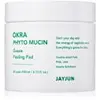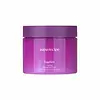What's inside
What's inside
 Key Ingredients
Key Ingredients

 Benefits
Benefits

 Concerns
Concerns

 Ingredients Side-by-side
Ingredients Side-by-side

Water
Skin ConditioningPropanediol
SolventDipropylene Glycol
Humectant1,2-Hexanediol
Skin ConditioningHibiscus Esculentus Fruit Extract
Skin ConditioningDioscorea Japonica Root Extract
Skin ConditioningNelumbo Nucifera Root Extract
Skin ConditioningPueraria Lobata Root Extract
HumectantPinus Palustris Leaf Extract
TonicUlmus Davidiana Root Extract
Skin ConditioningOenothera Biennis Flower Extract
AstringentCentella Asiatica Extract
CleansingHouttuynia Cordata Extract
Skin ConditioningArtemisia Vulgaris Extract
Skin ConditioningPhaseolus Radiatus Seed Extract
Skin ConditioningBetula Alba Bark Extract
MaskingRumex Crispus Root Extract
Skin ConditioningNatto Gum
Paeonia Suffruticosa Root Extract
Skin ProtectingGlycerin
HumectantPanthenol
Skin ConditioningSodium Hyaluronate
HumectantButylene Glycol
HumectantC12-14 Pareth-12
EmulsifyingGlyceryl Glucoside
HumectantDipotassium Glycyrrhizate
HumectantCapryloyl Salicylic Acid
ExfoliatingGluconolactone
Skin ConditioningBetaine Salicylate
AntimicrobialEthylhexylglycerin
Skin ConditioningDisodium EDTA
Water, Propanediol, Dipropylene Glycol, 1,2-Hexanediol, Hibiscus Esculentus Fruit Extract, Dioscorea Japonica Root Extract, Nelumbo Nucifera Root Extract, Pueraria Lobata Root Extract, Pinus Palustris Leaf Extract, Ulmus Davidiana Root Extract, Oenothera Biennis Flower Extract, Centella Asiatica Extract, Houttuynia Cordata Extract, Artemisia Vulgaris Extract, Phaseolus Radiatus Seed Extract, Betula Alba Bark Extract, Rumex Crispus Root Extract, Natto Gum, Paeonia Suffruticosa Root Extract, Glycerin, Panthenol, Sodium Hyaluronate, Butylene Glycol, C12-14 Pareth-12, Glyceryl Glucoside, Dipotassium Glycyrrhizate, Capryloyl Salicylic Acid, Gluconolactone, Betaine Salicylate, Ethylhexylglycerin, Disodium EDTA
Water
Skin ConditioningMethylpropanediol
SolventDipropylene Glycol
HumectantButylene Glycol
HumectantAllantoin
Skin ConditioningBetaine
HumectantGlycereth-26
HumectantSolanum Melongena Fruit Extract
Skin ConditioningCitric Acid
BufferingBetaine Salicylate
AntimicrobialGluconolactone
Skin ConditioningGlycyrrhiza Glabra Root Extract
BleachingCamellia Sinensis Leaf Extract
AntimicrobialCoptis Japonica Root Extract
Skin ConditioningSchisandra Chinensis Fruit Extract
Skin ConditioningZingiber Officinale Root Extract
MaskingGlycerin
HumectantEthylhexylglycerin
Skin ConditioningDisodium EDTA
Centella Asiatica Extract
CleansingCaprylyl Glycol
EmollientSodium Hyaluronate
HumectantBetula Alba Juice
AstringentMaltodextrin
AbsorbentMelaleuca Alternifolia Leaf Extract
PerfumingHydrolyzed Gardenia Florida Extract
AntioxidantScutellaria Baicalensis Root Extract
AstringentPolygonum Cuspidatum Root Extract
AntioxidantCalendula Officinalis Extract
Skin ConditioningChamomilla Recutita Flower Extract
MaskingRosmarinus Officinalis Leaf Extract
AntimicrobialWater, Methylpropanediol, Dipropylene Glycol, Butylene Glycol, Allantoin, Betaine, Glycereth-26, Solanum Melongena Fruit Extract, Citric Acid, Betaine Salicylate, Gluconolactone, Glycyrrhiza Glabra Root Extract, Camellia Sinensis Leaf Extract, Coptis Japonica Root Extract, Schisandra Chinensis Fruit Extract, Zingiber Officinale Root Extract, Glycerin, Ethylhexylglycerin, Disodium EDTA, Centella Asiatica Extract, Caprylyl Glycol, Sodium Hyaluronate, Betula Alba Juice, Maltodextrin, Melaleuca Alternifolia Leaf Extract, Hydrolyzed Gardenia Florida Extract, Scutellaria Baicalensis Root Extract, Polygonum Cuspidatum Root Extract, Calendula Officinalis Extract, Chamomilla Recutita Flower Extract, Rosmarinus Officinalis Leaf Extract
 Reviews
Reviews

Ingredients Explained
These ingredients are found in both products.
Ingredients higher up in an ingredient list are typically present in a larger amount.
Betaine Salicylate is considered a salicylic acid alternative.
Limited studies exist proving this ingredient to be a complete alternative to salicylic acid. Based on existing research, this ingredient does not penetrate as deeply and is not shown to be as effective.
However, this makes it a great choice for those with sensitive skin or need gentle BHA action.
This ingredient is created using betaine and salicylic acid.
This ingredient is oil-soluble and is most effective at a pH range of 3.8-4.2.
Learn more about Betaine SalicylateButylene Glycol (or BG) is used within cosmetic products for a few different reasons:
Overall, Butylene Glycol is a safe and well-rounded ingredient that works well with other ingredients.
Though this ingredient works well with most skin types, some people with sensitive skin may experience a reaction such as allergic rashes, closed comedones, or itchiness.
Learn more about Butylene GlycolCentella Asiatica Extract (Centella) is derived from an herb native to Southeast Asia. It is famous for its anti-inflammatory and soothing properties.
Centella is rich in antioxidants and amino acids, such as Madecassic Acid and Asiaticoside.
Studies show the compounds in centella help with:
The combination of all these properties makes centella effective at soothing, hydrating, and protecting the skin.
Other great components of centella include Vitamin A, vitamin C, several B vitamins, and Asiatic Acid.
Fun fact: Centella has been used as a medicine and in food for many centuries. As a medicine, it is used to treat burns, scratches, and wounds.
Learn more about Centella Asiatica ExtractDipropylene Glycol is a synthetically created humectant, stabilizer, and solvent.
This ingredient helps:
Dipropylene glycol is technically an alcohol, but it belongs to the glycol family (often considered part of the ‘good’ alcohols). This means it is hydrating and gentle on skin unlike drying solvent alcohols like denatured alcohol.
As a masking agent, Dipropylene Glycol can be used to cover the smell of other ingredients. However, it does not have a scent.
Studies show Dipropylene Glycol is considered safe to use in skincare.
Learn more about Dipropylene GlycolDisodium EDTA plays a role in making products more stable by aiding other preservatives.
It is a chelating agent, meaning it neutralizes metal ions that may be found in a product.
Disodium EDTA is a salt of edetic acid and is found to be safe in cosmetic ingredients.
Learn more about Disodium EDTAEthylhexylglycerin (we can't pronounce this either) is commonly used as a preservative and skin softener. It is derived from glyceryl.
You might see Ethylhexylglycerin often paired with other preservatives such as phenoxyethanol. Ethylhexylglycerin has been found to increase the effectiveness of these other preservatives.
Gluconolactone is a PHA. PHAs are a great gentle alternative to traditional AHAs.
When applied, Gluconolactone has the same affect on skin as AHAs such as lactic acid. It helps dissolve the dead skin cells in the top layer of your skin. This improves texture and brightens the skin.
PHAs are more gentle than AHAs due to their larger structure. They do not penetrate as deeply as AHAs and take a longer time to dissolve dead cells. Studies show PHAs do not cause as much irritation.
Gluconolactone has some interesting properties:
In a 2004 study, Gluconolactone was found to prevent UV damage in mouse skin cells and has not been found to increase sun sensitivity. However, we still recommend wearing SPF daily.
This ingredient is is an created by reacting gluconic acid with an alcohol.
Learn more about GluconolactoneGlycerin is already naturally found in your skin. It helps moisturize and protect your skin.
A study from 2016 found glycerin to be more effective as a humectant than AHAs and hyaluronic acid.
As a humectant, it helps the skin stay hydrated by pulling moisture to your skin. The low molecular weight of glycerin allows it to pull moisture into the deeper layers of your skin.
Hydrated skin improves your skin barrier; Your skin barrier helps protect against irritants and bacteria.
Glycerin has also been found to have antimicrobial and antiviral properties. Due to these properties, glycerin is often used in wound and burn treatments.
In cosmetics, glycerin is usually derived from plants such as soybean or palm. However, it can also be sourced from animals, such as tallow or animal fat.
This ingredient is organic, colorless, odorless, and non-toxic.
Glycerin is the name for this ingredient in American English. British English uses Glycerol/Glycerine.
Learn more about GlycerinSodium Hyaluronate is hyaluronic acid's salt form. It is commonly derived from the sodium salt of hyaluronic acid.
Like hyaluronic acid, it is great at holding water and acts as a humectant. This makes it a great skin hydrating ingredient.
Sodium Hyaluronate is naturally occurring in our bodies and is mostly found in eye fluid and joints.
These are some other common types of Hyaluronic Acid:
Learn more about Sodium HyaluronateWater. It's the most common cosmetic ingredient of all. You'll usually see it at the top of ingredient lists, meaning that it makes up the largest part of the product.
So why is it so popular? Water most often acts as a solvent - this means that it helps dissolve other ingredients into the formulation.
You'll also recognize water as that liquid we all need to stay alive. If you see this, drink a glass of water. Stay hydrated!
Learn more about Water